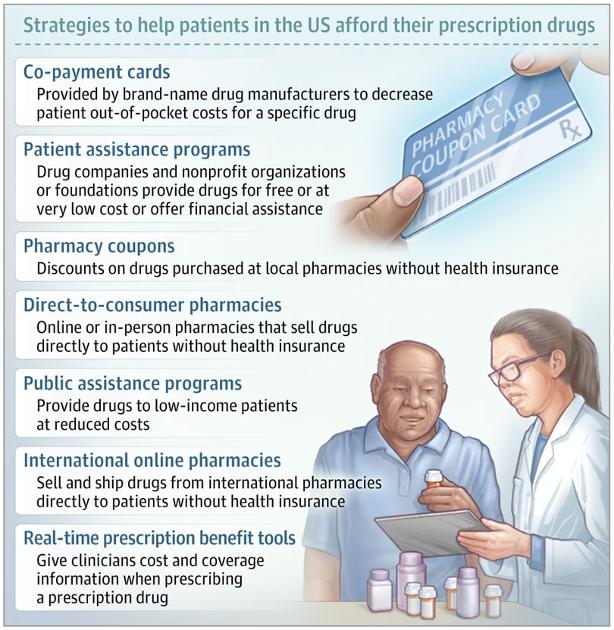Brigham researchers reviewed the benefits and limitations of seven strategies that clinicians can use to help their patients navigate high-prescription drugs. These include co-payment cards, patient assistance programs, pharmacy coupons, direct-to-consumer pharmacies, public assistance programs, international online pharmacies, and real-time prescription benefit tools.
They developed an algorithm covering how to think about the options to help patients afford their medicines based on the patient's insurance and the drug type (brand-name vs. generic).
Hussain S. Lalani, MD, MPH, MSc, of the Division of Pharmacoepidemiology and Pharmacoeconomics at Brigham and Women's Hospital, is the lead author of a paper published in JAMA, "Strategies to Help Patients Navigate High Prescription Drug Costs."
Prescription drugs can be expensive for patients, and many clinicians do not know how to respond when costs are too high. The researchers reviewed the benefits and limitations of seven strategies that clinicians can use to help their patients navigate high-prescription drugs.
These include co-payment cards, patient assistance programs, pharmacy coupons, direct-to-consumer pharmacies, public assistance programs, international online pharmacies, and real-time prescription benefit tools. The team developed an algorithm covering how to think about the options to help patients afford their medicines based on the patient's insurance and the drug type (brand-name vs. generic).
The researchers performed a comprehensive review of available data and information about each strategy and found that co-payment cards can lower out-of-pocket costs for privately insured patients taking brand-name prescription drugs.
For uninsured individuals or those with Medicare Part D who meet financial eligibility criteria, patient assistance or public assistance programs can help to access prescription drugs at reduced costs.
All patients can forgo health insurance and purchase drugs directly using pharmacy coupons or direct-to-consumer pharmacies, which sometimes offer lower prices for generic drugs than out-of-pocket costs for using health insurance.
Online international pharmacies provide a last resort for patients who cannot afford their brand-name drugs and do not qualify for the other strategies.
Prescribers can use real-time prescription drug benefit tools through their electronic health records to estimate patient out-of-pocket costs for prescription drugs and identify alternative lower-cost medicines for insured patients, but these tools can be inaccurate or incomplete.
Finally, some of these strategies, such as copayment cards and patient assistance programs, can raise overall health care spending by lowering the barriers to use expensive brand-name prescription drugs, even if less expensive alternatives are available.
The implications of the study have the potential to help many patients access existing strategies to afford their prescription drugs, say the researchers.
This patchwork of strategies to address drug affordability for patients highlights the structural and policy challenges in the current U.S. prescription drug market that impede access to affordable medicines for some patients. Using these strategies may help patients afford medications in the short term, but they do not address the root causes of high drug prices. (emphasis added)
* * *
Strategies to Help Patients Navigate High Prescription Drug Costs, JAMA Network, Special Communication - Health and the 2024 US Election, October 21, 2024
Hussain S. Lalani, MD, MPH, MSc1,2; Catherine S. Hwang, MD, MSPH1,2; Aaron S. Kesselheim, MD, JD, MPH1,2; et al Benjamin N. Rome, MD, MPH1,2
JAMA. Published online October 21, 2024. doi:10.1001/jama.2024.17275
* * *
The full paper is behind a paywall, but links to a "JAMA Patient Page" and to a 12:32 min podcast between JAMA Senior Editor Anne R. Cappola, MD, ScM, and 1st author Hussain S. Lalani, MD, MPH, MSc, of Brigham and Women's Hospital and Harvard Medical School that discuss these 7 "strategies". Acording to the podcast, the paper provides an "algorithm" that purports to assist doctors in finding the best pricing for any given script.
After listening to the podcast and having myself used various Medicare Part D insurance plans, ScriptCo online pharmacy, & Good Rx pharmacy coupons in the past, I can't imagine that many doctors are going to go through the time consuming effort it takes to find the lowest cost for the hundreds of prescriptions their practice might write in any given day. So, listen to the podcast and printout the "Patient Guide" PDF and expect to have to do the price evaluations yourself.
Here are links to the "Patient Guide" and to the podcast:
Patient Guide:
jamanetwork.com/journals/ja...
podcast:
edhub.ama-assn.org/jn-learn...
* * *
As j-o-h-n would maybe say about now, "Good Luck & Good Health"
When it comes to cancer meds, we need some of the first to have a chance at getting/keeping the second.
Ciao - cujoe
